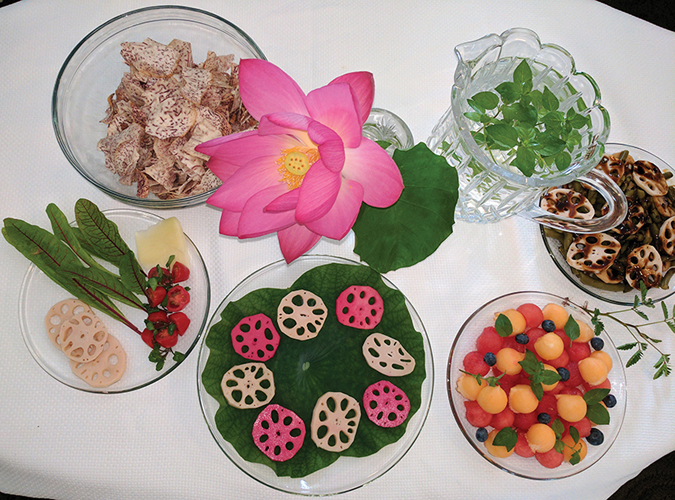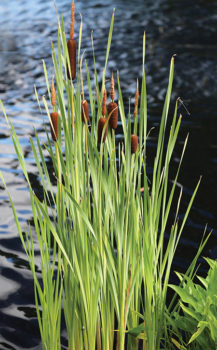
A fun way to add interest to your backyard pond is to add edible pond plants! They allow you to delight the senses as you add a green sprig of aquatic mint to your iced tea or cool, crisp watercress to your salad this evening. These garden-fresh elements add to outdoor entertaining as well as a healthy lifestyle.
Most people are unaware that there are many plants in the water garden that have long found their way to the dinner table. We’re not just talking sprouts on a salad — we’re talking about nutritious snacks like a bag of fresh, green lotus seeds that you can take on a hike, or a complex Thai dinner entrée that includes lotus tubers and Neptunia oleracea! Edible pond plants are an exciting way to enhance your outdoor living space.
A New Demand
The desire for beneficial environmental solutions is greater than ever before. Customers are collecting rainwater, using solar panels and employing bog filtration systems for their backyard ponds and water features. Along with healthy environmental choices, customers are making healthy lifestyle choices by adding fresh produce to their dinner table. The demand for edible pond plants is substantial. Adding a water feature to your backyard really changes the dynamics of daily living, and adding a water feature changes the ambience in the same way a fireplace does, drawing people in as well as adding another element to your surroundings.
Nurseries and garden centers are aware that there are hands-on customers who use every square inch of their yard, garden, water garden, pond or bog area to enhance their lives. One way to do that is to grow edible plants in their pond or water feature. Ponds have shallow areas and bog areas where edible pond plants can be grown and easily harvested. Plant pockets that are easily accessed are great for edible pond plants. Beautiful, aesthetically pleasing pond plants can be a delight to the eye and the palate!
Most plants thrive in a traditional garden, but there are many plants that thrive in water gardens, rain gardens and bogs. Taro and rice were among the first water plants to be cultivated thousands of years ago. They can be perfect for fresh salads or soups, stews, snacks, curries and stir-fry dishes.
Nelumbo Nucifera

The lotus is an exquisite flower to be sure, but it can be so much more. Garden centers and nurseries have row upon row of breathtaking lotus in pots for sale. Some companies sell lotus tubers online. Most of the lotus that are sold in the United States are for ornamental purposes and will adorn a sunny area of a pond or patio.
All parts of a lotus can be eaten and are even a staple in some countries. The fresh green seeds can be eaten like fresh peas. Once the seeds begin to turn brown, they have a nuttier taste and make a delicious and healthy snack. Lotus seeds are rich in protein, magnesium, potassium and phosphorus. Leaves, stems and tubers, as well as flowers are used in recipes. The tubers are great in stir-fry recipes. When the tubers are sliced, the star-shaped air chambers are exposed, making a beautiful and healthy combination. Lotus seeds offer anti-aging benefits in the form of L-isoaspartyl methyltransferase.
Lotus come in several colors, petal counts and sizes, from 8 inches to 6 feet tall. When choosing lotus as an edible vegetable, choose large varieties that produce large tubers. In Asia, there are individual cultivars used to grow large tubers and others that are cultivated for tremendous seed production. When planting lotus as an edible vegetable, they must be grown in shallow ponds. Our friend, Laura Bancroft of Ten Mile Creek Nursery, is currently working with a major company studying the health benefits and antioxidant properties of lotus. Laura grows more than 300 varieties of lotus, including some of the larger varieties like Perry’s Giant Sunburst or Deacon deGarmeaux, which are great for producing large tubers. Other varieties like Bold Protector are tremendous seed producers, while Space Lotus 36 produces large, edible tubers and seeds.
When purchasing lotus, consider their ultimate purpose. Other uses for lotus include tinctures, teas and medicinal purposes.
Turn Over a New Leaf
The Chinese water chestnut (Eleocharis dulcis) is sedge-like and emerald green in color, growing beautifully in shallow water. Water chestnuts are grown in many countries around the world for its edible corms. If you have ever had water chestnuts out of a can, you haven’t had real water chestnuts! Once you have tasted fresh Chinese water chestnuts, you’ll discover the rich, robust, nutty taste that adds the delicious crunch in stir-fry dishes.

On warm summer evenings when it is too hot to cook, fresh, healthy salads make a nice option for the dinner table. Watercress (Nasturtium officinale) is a perennial pond plant from the mustard family that grows well in moist bog areas around the pond. Watercress does especially well in cool, sunny weather. These are healthy, zesty, peppery greens that go great in salads and can be used in place of spinach in many recipes. Watercress is a superfood that takes top honors, surpassing the more popular kale in both vitamins and nutrients.
Another option is bloody dock (Rumex sanguineus), a nice, leafy, edible green plant with striking red veins on the leaves. This perennial pond plant is very easy to grow in part sun to part shade in moist soil. Tender young leaves can be added to salads for color and texture. However, bloody dock contains oxalic acid and should be used sparingly.
Water celery (Oenanthe javanica) is an edible water garden plant with soft shades of pink and green that grow well in shallow water in sunny locations in your pond. The leaves and stems are eaten raw in salads or used as a garnish for meat dishes. It is also an excellent addition for soups and stews, adding a subtle celery taste.
Taro Tricks
One of the most impressive plants you can grow this summer is taro. It adds the feel of the tropics to your pond, pool or patio. Taro (Colocasia esculenta) has been used as a staple in many countries, including China, Japan and across Southeast Asia and the Pacific Islands as a dietary mainstay. It spread by cultivation from India, Nepal and Bangladesh into Southeast Asia.

Taro has been used for years on the Hawaiian Islands to make poi, the equivalent to mashed potatoes. The taro root is used in much the same way that we use potatoes or turnips in soups or stews. Corms, leaves and petioles may also be eaten. Taro is an acquired taste, although to some, taro root has a sweet, nutty flavor. Taro is quite healthy — low in calories and high in fiber and vitamin B-6. Taro chips are a healthy alternative to potato chips. Taro grow well in moist, sunny areas of the bog, in shallow water or with an inch or two of water over the top of the pot in the pond. Beautiful and versatile, taro comes in many varieties and can grow quite large. Leaves on some taro grow to 3 feet long! Taro is hardy in Zones 8 to 11, but it grows quickly throughout the summer months in the north, where it can be purchased as an annual. Many people tend to overwinter their taro indoors.
Spices, Teas & Cattails
When you are out by the pond enjoying a tall glass of iced tea, add a sprig of aquatic mint. Mentha aquatica is a lovely herbaceous plant that flowers all summer long with lavender blooms and attracts butterflies. It grows especially well in moving water and does well in stream beds. It can be wonderfully refreshing when creating flavored waters —“ just add a few sprigs of mint to a pitcher of water along with lemon and lime slices, and chill! Menthe aquatica may also be used as a garnish for fruit compotes or meat dishes.
When summer evenings begin to cool down, a cup of hot tea is in order. Lemon bacopa tea is divine. Just crush a few leaves of Lemon bacopa (Bacopa caroliniana), place in a cup and pour hot water to add a subtle, sweet hint of fresh lime to your cup of tea. This is a delightful, flowering pond plant that grows well in moist areas of the bog, or as a submerged or emergent plant in the pond.

Cattails (Typha latifolia) are usually found at the edge of a pond, in marshes or stream beds. Cattails can become aggressive, so be careful where you plant them. The tender, young stems on cattails can be eaten raw or boiled, and they taste like corn. The cattail flowers can be roasted, and the lower parts of the leaves can be used in salads. Cattail pollen can be collected from the plants and used as a thickening agent in soups and stews or added to pancake batter for extra nutrition.
Spice up your life! Sweet flag (Acorus calamus) is often seen growing at the edge of a pond, in marshes or on stream and river banks. The sweet flag plant is a perennial and highly aromatic. It has sword-shaped, green and yellow-striped leaves and can be found throughout the Northern Hemisphere. It has a spicy lemon fragrance and is used as a flavoring for gin, tonics and vermouth. Sweet flag rhizomes and foliage have a sweet fragrance. The rhizome can be used in the place of ginger root.
For an exotic twist, Neptunia oleracea (more often called Neptunia aquatic or water mimosa) floats effortlessly on the surface of the water. The tender young leaves, shoots and pods can be eaten. When eaten raw, Neptunia oleracea has a cabbage-like taste. It is often used in Vietnamese and Thai recipes for soups, stews, curries and spicy salads, and it tastes wonderful when used in kaeng som, a sour curry. When preparing Neptunia oleracea for stir-fry, make sure to remove the spongey outer layer to reveal the tender young stems. Roots of Neptunia oleracea are often used for medicinal purposes as well.
Planting Tips
When planting edible pond plants, use heavy loam soil or Turface MVP in your pond and allow the leafy greens to grow above the water line.
Also consider using edible plants in your bog filters. Taro and water celery are excellent choices for this. To keep your bog filter from clogging up, always dig your bog filter 2 feet deep and use Turface MVP or a 50-50 mix of Turface MVP and 1/8-inch to ¼-inch pea gravel. Using pea gravel larger than ¼ inch may inhibit plant growth or crush plant roots. You can plant your edible pond plants in fabric planters and place them in the stream bed of your pond so that the water recirculates back to the pond. This is a perfect way to get healthy, oxygenated water to your plants while simultaneously cleaning your water and keeping it fresh.

You may add a few goldfish to your pond to help fertilize naturally and keep mosquito larvae at bay. Pond tabs or fertilizer may be used, but never use fish medications or chemicals in your pond, or your once-edible plants will be rendered inedible!
These are just a few of the edible pond plants that can be grown in shallow water in a backyard pond, adding beauty and productivity to your water garden feature while enhancing a healthy lifestyle. When creating a pond or water feature that includes a space for growing edible plants, choose a sunny spot with no overhead trees nearby. Also make sure to choose an area that is easily accessible, and grow your edible plants in shallow areas of the pond, plant pockets or bog areas.
Edible pond plants can add a pleasing aesthetic value as well as an international flair to your outdoor living space while encouraging wholesome eating habits.
The article was written by Zac and Nancy DeGarmeaux at Pond Megastore.


